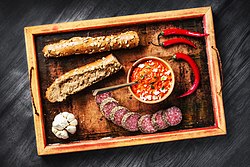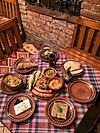Ajvar
 Ajvar with bread, garlic, pepper and salami | |
| Region or state | Balkans |
|---|---|
| Main ingredients | Capsicum (bell peppers), oil, salt |
Ajvar (/ˈaɪvɑːr/ EYE-var; Serbian Cyrillic: Ajвар, Bulgarian: Aйвар, romanized: Ayvar) is a condiment made principally from sweet bell peppers and eggplants.[1] The relish became a popular side dish throughout Yugoslavia after World War II and remains popular in Southeast Europe.
Homemade ajvar is made of roasted peppers.[2] Depending on the capsaicin content in bell peppers and the amount of added chili peppers, it can be sweet (traditional), piquant (the most common), or very hot. Ajvar can be consumed as a bread spread or as a side dish. Ajvar has a few variations. One variation contains tomato and eggplant, and another green bell peppers and oregano.
"Homemade Leskovac Ajvar" and "Macedonian Ajvar" are registered with the World Intellectual Property Organization in order to protect their brand names.[3]
Etymology and origin
The name ajvar comes from the Turkish word havyar, which means "salted roe, caviar" and shares an etymology with "caviar", coming from the Persian word xaviyar.[4][5] Before the 20th century, significant local production of caviar occurred on the Danube, with sturgeon swimming from the Black Sea up to Belgrade.[6] Domestic ajvar, meaning "caviar", used to be a very popular dish in Belgrade homes and restaurants,[7] but the domestic production of caviar became unsteady in the 1890s because of labor disputes. Eventually a special pepper salad was offered as a substitute in Belgrade restaurants under the name "red ajvar" (crveni ajvar) or "Serbian ajvar" (srpski ajvar).[8]
Preparation

Homemade ajvar is made of peppers that are roasted, minced, and then cooked, but some industrial producers use fresh minced peppers, which are only cooked with sunflower oil afterwards, which leads to lower quality. Ajvar preparation is somewhat difficult, because it requires considerable manual labour, particularly for peeling the roasted peppers. It is traditionally prepared in mid-autumn, when peppers are most abundant, and preserved in glass jars for consumption throughout the year. Anecdotally, most households' stocks do not last until the spring, when fresh vegetables become available, so it is usually enjoyed as a winter food. Entire families or neighbours often gather to prepare the peppers together.[citation needed] The traditional cultivar of pepper used is called roga (approx. "horn"). Roga is large, red, horn-shaped and relatively easy to peel, with thick flesh. It typically ripens in late September.[citation needed]
To produce ajvar, fresh peppers are roasted whole on a plate above an open fire,[9] a plate of wood in a stove, or in an oven. The baked peppers must briefly cool to allow the flesh to separate from the skin. Next, the skin is carefully peeled off and the seeds are removed. The peppers are then ground in a mill or chopped into tiny pieces (this variant is often referred to as pindjur). Finally, the resulting mash is stewed for several hours in large pots. Sunflower oil is added at this stage to condense and reduce the water, and to enhance later preservation. Salt is added at the end (sometimes alongside vinegar), and the hot mush is poured directly into sterilized glass jars, which are sealed immediately.[citation needed]
Production

This section needs additional citations for verification. (May 2021) |
Ajvar is produced in most Balkan countries,[10] including Albania, Bosnia, Croatia, North Macedonia, Slovenia and Serbia. Serbia's reported annual production is 640 tons.[11]
Ajvar is often included as part of zimnica (winter foods), which include pickled chili peppers, pickled tomatoes, and anything else that can be preserved in a jar just before winter.[12][13]
See also
- Ljutenica – Vegetable relish or chutney in Bulgarian, Macedonian, Serbian and Turkish cuisines, a similar relish in Bulgarian, Macedonian, and Serbian cuisines
- Pindjur – Relish spread in the Balkan peninsula, a similar relish in Bosnian, Macedonian, and Serbian cuisines
- Zacuscă – Romanian-Moldovan dish, a similar relish in Romanian cuisine
- Kyopolou – Bulgarian-Turkish dish, an eggplant-based relish in Bulgarian and Turkish cuisines
- Malidzano, a similar relish in Macedonian cuisine
- Biber salçası – Paste made from peppers or tomato and salt, originating in Turkey, a Turkish paste made from red peppers alone
- Lecso – Hungarian dish, a similar Hungarian (also made in parts of Slovakia and Serbia) stewed red pepper, onion, and garlic dish
- List of spreads
- Achar – Pickled varieties of vegetable and fruit, a similar relish of Indo-European origin in South Asian cuisines
References
- ^ "How to Make Serbian Vegetarian "Caviar" or Ajvar". The Spruce Eats. Retrieved 25 October 2020.
- ^ "Ajvar (Serbian Roasted Red Pepper Sauce) Recipe". www.seriouseats.com. Retrieved 25 October 2020.
- ^ "How this traditional Balkan red pepper spread brings the neighbourhood together". Hindustan Times. 2017.
- ^ "Havyar".
- ^ Etimološki rečnik srpskog jezika I, 2003, s.v. ajvar
- ^ Josip Pančić (1860). Pisces Serbiae. p. 33.; Mihailo Petrović (1941). Đerdapski ribolov.
- ^ "Belgrade through the ages". 7. 1960: 61, 64.
{{cite journal}}: Cite journal requires|journal=(help); Dušan J. Popović (1964). Beograd kroz vekove. pp. 93, 215, 241. - ^ Malcolm Burr (1935). Slouch hat. p. 165.; Lovett Fielding Edwards (1954). Introducing Yugoslavia. p. 79.
- ^ "Making Ajvar". 16 July 2011. Archived from the original on 16 July 2011. Retrieved 15 December 2017.
- ^ "Ajvar: The vegan 'caviar' of the Balkans". www.bbc.com. Retrieved 25 February 2024.
- ^ "Vegetable Industry in Serbia" (PDF). Serbia Investment and Export Promotion Agency.
- ^ "zimnica - Medicinski leksikon". medicinski.lzmk.hr. Retrieved 25 February 2024.
- ^ "Dobra Hrana - Svi recepti koje ćete trebati za pripremu zimnice!". www.jutarnji.hr (in Croatian). 14 September 2016. Retrieved 25 February 2024.
External links
- "Fall Brings Red Peppers and Ajvar, 'Serbian Salsa'". NPR. 8 November 2006. (article and recipe)
- "Ajvar srpski kavijar" (in Serbian). Novosti. 2013.
- "Leskovčanka po čijem receptu je brendiran srpski ajvar ušla u biznis kad je ostala bez posla". Blic (in Serbian). 2012.
- "Ajvar - Top-notch gastronomic delight, vegan soul food, recipes and origin". Ajvar.com. 2017.




